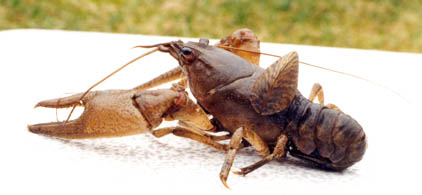Insider View #1
Did you know that zebra mussel larvae are so light they float, suspended
in the water until they grow heavy enough to sink?
So how long does it take a zebra mussel to grow large enough to sink?
About the same amount of time it takes to float 100 miles in the Mississippi River.
That’s why there are major zebra mussel infestations at the twin cities,
Lake Pepin and again at Prairie De Chien, WI.
So how long would it take a larval zebra mussel to go from being suspended
in the bilge water of a boat to sinking to a new home in our lake?

Zebra mussel attached to the back of a crayfish.
FAQ’s about zebra mussels.
http://fl.biology.usgs.gov/Nonindigenous_Species/Zebra_mussel_FAQs/zebra_mussel_faqs.html
Insider View #2
Yellow Perch
In April to May, when the water is 44 to 52 degrees Fahrenheit, female yellow perch swim to their favorite spawning places near weeds or submerged brush and lay gelatinous strands of eggs that are up to seven feet long.
Most strands of yellow perch eggs contain 28,000 eggs each!
That’s a lot of mouthwatering bites for newly hatched fry of walleye and bass and northern pike.
Perch have brush like teeth used to eat small aquatic insects, and comb like gill rakers that strain minute zooplankton from the water.
Game fish like walleye and northern pike have long, sharp canine teeth for grabbing and eating other fish.
Perch are relatively slow swimmers.
